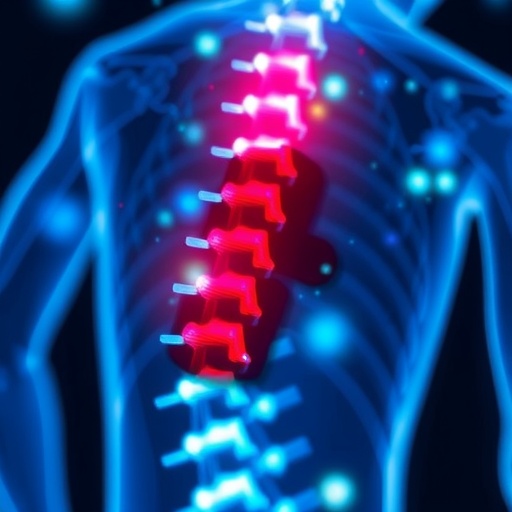
Spinal cord injuries pose a formidable challenge in contemporary medicine, disrupting communication between the brain and body and often resulting in irreversible loss of motor and sensory functions. Currently deemed incurable, these traumatic injuries profoundly alter the lives of those affected, leading to a cascade of physical, emotional, and social consequences. However, recent advancements emerging from Waipapa Taumata Rau, the University of Auckland, offer a glimmer of hope for affected individuals. Researchers have embarked on a groundbreaking trial that explores an innovative approach to treatment, potentially transforming the landscape of rehabilitation for spinal cord injuries.
The spinal cord serves as a crucial conduit for neural signals, transmitting messages from the brain to various body parts and vice versa. This transmission is compromised in the event of an injury, likened to a severed electrical wire, leading to disrupted motor function and sensation. Dr. Bruce Harland, a senior research fellow in the School of Pharmacy at the University of Auckland, emphasizes the stark contrast between superficial skin wounds that typically heal without intervention and the intricate complexities of spinal injuries, which possess a limited ability to regenerate. The urgency for effective therapeutics in this domain cannot be overstated, as the societal impact of such injuries persists.
In an innovative endeavor to tackle this formidable challenge, scientists have turned their attention to the role of bioelectricity in promoting nervous system development. Before birth, and to a diminishing extent postnatally, the body generates inherent electric fields that guide the growth and organization of nerve tissue. Researchers have harnessed these naturally occurring electric fields to develop an implantable electronic device aimed at restoring function post-injury. By applying concentrated electrical signals to the site of injury within the spinal cord, this device promises to stimulate regrowth and enable recovery of lost functions.
.adsslot_26PjQxS9yi{ width:728px !important; height:90px !important; }
@media (max-width:1199px) { .adsslot_26PjQxS9yi{ width:468px !important; height:60px !important; } }
@media (max-width:767px) { .adsslot_26PjQxS9yi{ width:320px !important; height:50px !important; } }
ADVERTISEMENT
The state-of-the-art implant, characterized by its ultra-thin design, is strategically placed over the injury site in experimental models. The device is engineered to deliver meticulously calibrated electrical currents, stimulating healing and providing the injured spinal cord with signals analogous to those it would receive during natural recovery processes. This dual approach not only seeks to restore movement but also to reinstate sensory feedback, an often-overlooked aspect of recovery that significantly influences the quality of life for individuals suffering from spinal cord injuries.
Research utilizing rodent models, primarily rats, has revealed promising results from this experimental treatment. Unlike humans, rats have a notable capacity for spontaneous recovery following spinal cord injury, making them an ideal subject for comparative studies. Over a four-week treatment period during which the devices were implemented, researchers observed remarkable improvements in movement among those receiving electrical stimulation compared to their untreated counterparts. The treated animals displayed increased responsiveness to tactile stimuli, suggesting that not only motor functions were benefitted but sensory perception was also enhanced.
The implications of these findings are profound, indicating that the electrical treatment effectively supports both motor and sensory recovery without inflicting additional harm or inflammatory responses within the spinal cord. As Dr. Harland points out, safety is a paramount concern in any therapeutic strategy, particularly when addressing such delicate and complex bodily systems. The successful outcomes from this study could pave the way for future clinical applications, granting new hope to individuals enduring the challenges of spinal cord injuries.
Publishing this significant research in the renowned journal Nature Communications, the collaboration between the University of Auckland and Chalmers University of Technology in Sweden demonstrates a robust international effort to tackle the intricacies of spinal cord healing. Professor Maria Asplund, a key figure in this collaboration, articulates a vision where this technology could evolve into a clinically viable medical device, profoundly changing the treatment paradigm for those living with spinal cord injuries.
As researchers delve deeper into their findings, the next logical step involves examining various treatment parameters, including the strength of the electrical fields, frequency of stimulation, and the overall duration of treatment. By pinpointing the most effective combinations, scientists aim to optimize the recovery process, crafting a carefully tuned therapeutic approach to spinal cord repair. This continuous inquiry underscores a commitment to refining methods and maximizing patient outcomes.
Every advancement in the fight against spinal cord injury carries with it the potential for transformation. Individuals who once faced a future defined by limitation may soon find themselves equipped with renewed agency and independence. Moreover, the implications extend beyond human patients; advancements in this realm could benefit pets and other animals suffering from similar debilitating conditions, reflecting a wide-ranging application of the underlying technology.
In conclusion, the trailblazing research emerging from Waipapa Taumata Rau signals a pivotal moment in treating spinal cord injuries. By leveraging the principles of bioelectricity and biomedical engineering, researchers are crafting methods that not only demonstrate efficacy in restoring function but also prioritize safety and patient well-being. As we stand on the threshold of these exciting advancements, the hope for effective interventions that can significantly enhance the quality of life for those affected by spinal cord injuries becomes increasingly tangible, heralding a future where regeneration and recovery may no longer be mere aspirations but attainable realities.
Subject of Research: Animals
Article Title: Daily electric field treatment improves functional outcomes after thoracic contusion spinal cord injury in rats
News Publication Date: 26-Jun-2025
Web References: https://www.nature.com/articles/s41467-025-60332-0
References:
Image Credits:
Keywords
Health and medicine
Applied sciences and engineering
Tags: breakthrough medical device researchchallenges in spinal cord injury therapiesDr. Bruce Harland research contributionsemotional impact of spinal cord injuriesexploration of spinal injury therapeuticsinnovative spinal cord treatmentsmotor function recovery innovationsneural signal transmission restorationrehabilitation advancements for spinal injuriesspinal cord injury recoverytransformative rehabilitation solutions for spinal injuriesUniversity of Auckland spinal research



